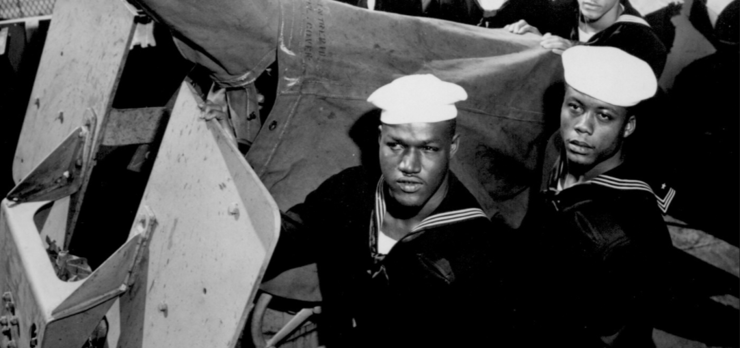











































When Ernie Spence arrived as the new commanding officer for the Navy's largest F -18 training squadron, he was met with disarray. Of the squadron's 117 planes, most had fallen into disrepair - leaving just one plane safe to fly. As a result, the team responsible for training about 60 percent of Navy squadron pilots was more than a year and a half behind schedule.
The maintenance and spare parts delivery schedules for the Navy aircraft had been planned back in the 90s. As American involvement in the Middle East began to ramp up a decade later, Navy missions required these planes in action far more than initially expected. The squadron quickly found itself going through its spare parts at a much faster rate than it had resourced for, forcing planes out of commission while awaiting components that never came. As time wore on, the squadron deferred regular maintenance on the idle aircraft, eventually even using them as sources of spare componentry for other planes in need of repairs. Soon, the amount of work it would take to bring any single plane back to service became far too daunting to take on.
"While there were external pressures, the majority of the group's issues were internal."
The way Ernie saw it, while there were certainly external factors that put the squadron in a difficult situation, the majority of the group's issues were internal.
"There are externalities that affect every organization," Ernie says. "But does the leadership actually take stock and measure what the effects of those will be? Do they allow the cumulative effect to pile up to the point where they appear to be unmanageable? If so, what becomes the tipping point where they decide, 'We have to start dealing with this issue?'"
To remedy the mindset that made the squadron so vulnerable to change, Ernie set out to augment its culture.
Implementing culture change in a complex environment
The F -18 training squadron is the Navy's largest, comprised of about 1,300 military personnel, contract partners and government civilian employees spread across multiple sites. Implementing deep and lasting cultural change is never easy, but it is made far more difficult in such a complex environment. To truly change the way the squadron approached its work, Ernie had to engage with people both as individuals and as a collective unit.
"Every single individual in an organization has the ability to make a difference." Ernie says. "But for the organization to truly be successful, every single person must contribute to making that difference."
"That was the fundamental difference in culture that the squadron was missing. It was the notion that of those 1,300 folks there, any one of them could have sent them on the path to making the squadron better and more capable of operating the way it should have been. But, in order to really get the results that were required, we had to get every single person on board and working toward the same collective goal, taking a very methodical approach to how we were doing business."

Seeking alignment through belief
To align the group, Ernie's first step was to decide what a culture of success would look like. What mission, vision and values did they have to embrace to better perform their jobs? Having defined these ideas, the next step was to figure out how to turn them into action. In Ernie's squadron, this posed a particular challenge. Because military leadership is relatively transient, people who don't agree with particular leaders' strategies can simply wait them out, resisting change until the commanding officer is replaced. So, Ernie knew he could not be passive - he had to actively make sure every individual bought in to the new culture.
What Ernie realized motivated most people was meaning. For the problem he witnessed wasn't that people weren't willing to work hard, but that they believed their jobs didn't matter.
"Once an organization starts to falter, it's easy for folks to come to work and say, 'It's not important what I do today,'" Ernie says. "What I saw in that particular squadron is that a lot of folks were coming to work and they were working very hard, but they were working on things that were meaningful to them at a very individual level - they were not contributory and not focused or coordinated across the entire organization. You had a lot of folks that were doing a lot of things, but not working toward what the squadron existed for."
DOWNLOAD THE WHITEPAPER: Creating a Culture of Operational Excellence Discipline that leads to Operational Excellence
Before he could expect someone to get behind the culture, he had to demonstrate why the new mission was meaningful, then explain precisely how that person's job would contribute to realizing the mission. Having inspired belief in the new culture, Ernie eliminated actions and processes that did not align with the squadron's values or move it closer to its mission. In their stead, the leadership established a new set of fundamental expectations designed to guide future action toward the squadron's mission.
Cementing culture with constant communication
To drive their importance home, Ernie made these expectations the focal point of every policy decision, newsletter publication, team meeting, performance review and hiring decision going forward. Every action the squadron took from then on was shaped by the culture it was striving toward.
"Driven by a new organizational culture, Ernie's squadron saw dramatic results."
After about six months of constant communication, every member of the squadron was able to repeat from memory the group's mission and the expectations that guided their behavior. According to Ernie, this is when he truly began to see a shift in the squadron's day-to-day productivity toward the goals they had set out to achieve. Rather than taking his foot off the gas when he smelled success, Ernie says the key to sustaining the new culture was working as hard to promote it after six months as they did on day one.
Driven by a new organizational culture, Ernie's squadron saw dramatic results. Within six months, it had managed to bring about 20 airplanes back into service. By the time a year went by, it had completely restored nearly 60 planes, returning about $3.5 billion worth of Navy aircraft to the skies. With a functional fleet back in the air, it took less than a year for the squadron to get on pace to complete its training schedule. Plus, the new operating models were more efficient, cutting maintenance costs by as much as 36 percent.
View our schedule of industry leading free to attend virtual conferences. Each a premier gathering of industry thought leaders and experts sharing key solutions to current challenges.
View Schedule of Events-------------------------------------------------------
Search for anything
Insights from the most progressive thought leaders delivered to your inbox.
Insights from the world's foremost thought leaders delivered to your inbox.
Being a hero is all about creating value for others. Please invite up to 5 people in your network to attend this premier virtual conference, and they will receive an invitation to attend.
If it’s easier for you, please enter your email address below, and click the button, and we will send you the invitation email that you can forward to relevant people in your network.
View our schedule of industry leading free to attend virtual conferences. Each a premier gathering of industry thought leaders and experts sharing key solutions to current challenges.
View Schedule of EventsWatch On-Demand Recording - Access all sessions from progressive thought leaders free of charge from our industry leading virtual conferences.
Watch On-Demand Recordings For FreeDelivered by the industry's most progressive thought leaders from the world's top brands. Start learning today!
View All Courses NowThe premier Business Transformation & Operational Excellence Conference. Watch sessions on-demand for free. Use code: BFH1120
Watch On-DemandInsights from the most progressive thought leaders delivered to your inbox.
Insights from the world's foremost thought leaders delivered to your inbox.
Being a hero is all about creating value for others. Please invite up to 5 people in your network to also access our newsletter. They will receive an invitation and an option to subscribe.
If it’s easier for you, please enter your email address below, and click the button, and we will send you the invitation email that you can forward to relevant people in your network.
Courtesy of Nintex Pty's Paul Hsu, below is a transcript of his speaking session on 'Improve employee productivity during and post-COVID by ...
Read this article about HP, Best Achievement in Operational Excellence to deliver Digital Transformation, selected by the independent judging panel, ...
Read this article about BMO Financial Group, one of our finalists, in the category Best Achievement in Operational Excellence to deliver Digital ...
Read this article about Cisco, one of our finalists, in the category Best Achievement of Operational Excellence in Internet, Education, Media & ...









































































































































































































